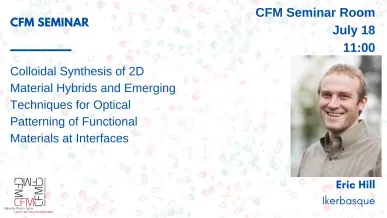Colloidal Synthesis of 2D Material Hybrids and Emerging Techniques for Optical Patterning of Functional Materials at Interfaces
Eris Hill
Ikerbasque
CFM Seminar Room
Silvina Cerveny

Colloidal modification of nanomaterial interfaces can provide a chemical environment that favors nucleation, growth, and assembly. In this talk, I will first present how layered nanomaterial edges and basal surfaces can provide different chemical environments suitable for templating interfacial colloidal synthesis. The growth of semiconductors at the basal interface of layered nanomaterials can result in 2D heterostructures with colloidal properties derived from both template and grown material, while also improving functional properties for applications such as photocatalysis. In another direction, the grafting of molecular chromophores independently to the edges or basal surfaces of 2D materials can provide a unique approach to study particle aggregation, inter-particle separation, and other colloidal properties indirectly via intermolecular energy transfer. Finally, I will discuss our ongoing efforts in using interfacial chemistry to influence the colloidal assembly of nanomaterials on solid substrates with emerging optical printing techniques. Specifically, our recent progress on patterning of nanomaterial assemblies with laser-driven microbubbles and opto-thermophoresis will be presented, as these techniques show promise for patterning of functional materials at interfaces.
